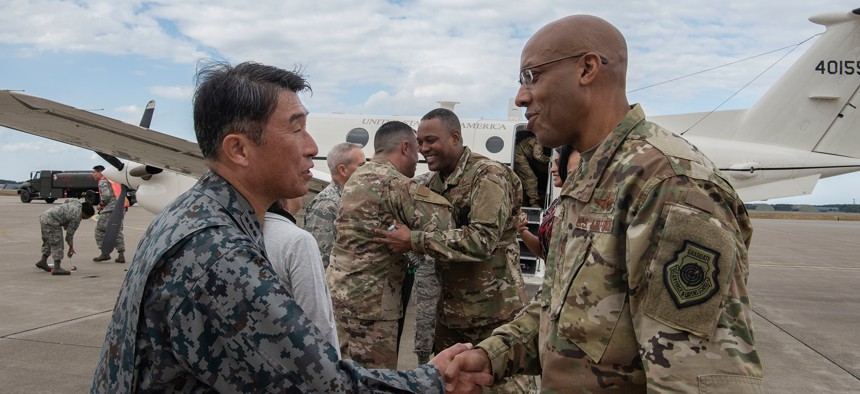The Air Force Is Redrawing Its Pacific-War Playbook for China
New Pacific Air Forces chief wants deeper cooperation with allied militaries — and better drills for when comms go down.
If the United States has to go to war with China, its top Air Force general in the Pacific region wants allies more tightly woven into the battle plans — and ready to execute even when communications go down.
So Gen. Charles Brown is laying out new tactics and concepts of operations to be practiced in updated drills and wargames, the commander of Pacific Air Forces said Monday. Those drills might include fewer aircraft and people than has become customary — but that’s also part of the point.
“How do we move small packages around pretty quickly to complicate things for our adversary,” Brown told reporters at the Pentagon. “[T]hen also how to operate in a contested environment, because I can’t guarantee that my [communications] will be up the entire time. So how do folks actually, don’t wait for direction, they get enough direction early enough from me so that they can actually go execute.”
Brown, who has been the Air Force’s top general in the Pacific for about four months, is working to “operationalize” a classified Pacific Air Forces strategy put together by his predecessor, Gen. Terrence O'Shaughnessy, now the commander of U.S. Northern Command.
“When we look at our pacing threat of China, we got to think differently about how we do things,” Brown said. “We can’t continue to do things we’ve already done. It’s really looking at new operational concepts, thinking outside the box a bit more.”
Brown talked at length about working more with allies in the Pacific. The U.S. Marine Corps has based new F-35 Joint Strike Fighters in Japan. Japan, South Korea and Australia are buying F-35s, and Singapore is also interested.
It’s a change from the way the Air Force has generally trained with its Pacific allies.
“Some of the exercises we have, it’s the same exercise we’ve been doing for the past X number of years,” Brown said. “It’s really, ‘How do you take that exercise to the next level or focus on certain aspects that are going to make us more capable together?’”
Brown said he would like to beef up stocks of long-range cruise missiles in the Pacific, including the extended-range version of the Joint-Air-to-Surface Standoff Missile, or JASSM-ER, and Long-Range Anti-Ship Missile, or LRASM, two Lockheed Martin-made weapons with ranges of hundreds of miles. In the longer term, he wants hypersonic weapons.
“Standoff weapons are always a plus because it decreases risk for our aircrews,” he said.
The general compared the surface-to-air missile situation on China’s artificial islands as similar to that in Syria.
“[T]here’s a difference between capability and intent,” he said. “There may be capability to put things there, but the intent to actually use it to start a conflict is a different aspect.”
Brown spent a year as the commander of air forces in the Middle East, overseeing the bombing campaign against Islamic State militants in Iraq and Syria for parts of 2015 and 2016. He then spent two years as the deputy commander of U.S. Central Command.
“Pretty capable SAM systems in Syria, but there wasn’t intent to use those against the coalition,” he said. “I would say the same thing in this case right now in the South China Sea.”
So far, Brown said, China has not been targeting U.S. warplanes with those missiles. “I haven’t seen anything that’s been provocative to speak of in the air,” he said.
“If they arm those weapons, then we’re in a little bit different ballgame,” the general said. “The way I look at it right now: we can fly there.”
But the general warned that American planes would defend themselves. “If the tensions go up, then we’re going to defend ourselves and we have an inherent right of self-defense,” he said.
Brown noted the Chinese military’s intercepts of American intelligence aircraft, which he described as “sporadic.”. Asked whether any of those recent intercepts have been unsafe, he said, “Not necessarily. There’s some that we characterize maybe a little bit unprofessional — a little more aggressive than others…By and large, they’ve been safe and professional.”




